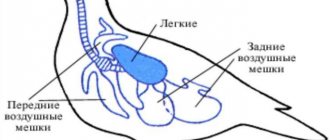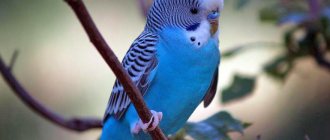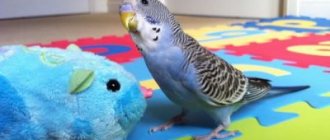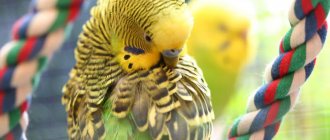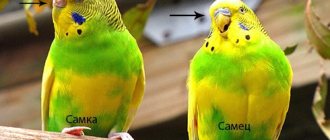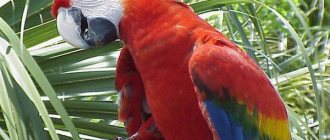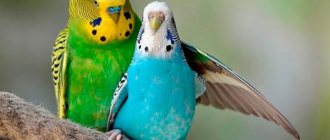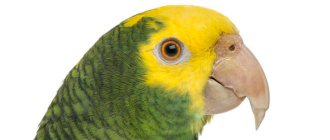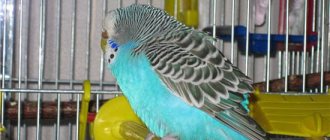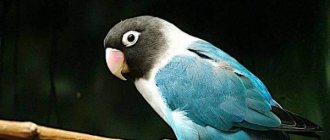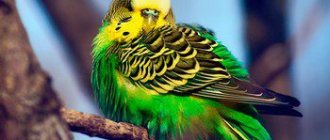Diseases of budgies
The lion's share of budgerigar diseases is a consequence of improper maintenance, insufficient care, and poor nutrition. Signs of illness in a budgie can be determined for some visual reasons. The usually cheerful, restless, never-silent and curious creature suddenly becomes lethargic, sits ruffled on a perch for hours, and shows no interest in either new objects or food. The plumage also reacts quite quickly to the condition of its owner, becoming dull and unkempt. The parrot does not chirp, does not bathe, and constantly sleeps in an unusual position for it.
Obesity
The result of improper feeding, overeating and a sedentary lifestyle can be overweight. Sometimes the cause of this condition is a malfunction of the thyroid gland.
Sick birds become rounder and develop a layer of fat in the abdomen and chest area. Parrots weaken and become lethargic. Due to their large body weight, it is difficult for them to rest on their paws, so they may lie on their stomach. Shortness of breath appears, the functioning of all internal organs is disrupted.
To prevent obesity, limit your pet's consumption of high-calorie foods: hemp, oatmeal, canary seed. Raw vegetables and fruits, greens are given in sufficient quantities. The bird must be released from the cage every day for at least a couple of hours under supervision. The cage should not be too tight. It is advisable to install various perches, swings and ropes in it to increase the activity of the parrot in the limited space of the house.
Common diseases
Cold
Budgerigars are very sensitive to sudden temperature changes, drafts, and too cold water in the drinking bowl and bathing bowl. The optimal room temperature for them is 22-24 degrees, the water should be pleasant to the touch.
Symptoms:
Treatment:
Before the ornithologist arrives, additional heat should be installed in the cage with the sick bird. To maintain strength, add a few drops of lemon, honey or chamomile infusion to the drinking bowl.
For a severe cold accompanied by coughing, sneezing, or nasal discharge, inhale with chamomile, eucalyptus, and mint.
These procedures are only supportive until the main treatment is prescribed. And do not forget that cold symptoms can occur in a number of other diseases, so consulting a doctor is extremely necessary.
Poisoning
A parrot can be poisoned by low-quality or expired food, stagnant or chlorinated water, indoor plants, household chemicals or medications. The bird's well-being may worsen from the pungent odors of household solvents and paints, tobacco smoke, aerosols and air fresheners.
Symptoms of poisoning:
Treatment:
Goiter inflammation
Goiter disease in budgies occurs primarily after feeding it low-quality food. But it can also be caused by parasites, bacterial and fungal infections. The first symptoms of budgerigar disease, while it is easily curable, may not be noticeable, making it extremely dangerous. Neglected disease or self-medication can be fatal.
Symptoms:
Treatment:
Depends on the stage of the disease. You can provide first aid yourself by warming the bird under a lamp. The main treatment for budgerigars is carried out in a hospital. After tests and washing of the goiter, antibiotics, dietary nutrition, and restoration of the mucous membrane with the help of herbal decoctions are prescribed.
Scabies mite
The disease of budgies caused by the scabies mite is called knemidocoptic mange. It manifests itself in the area of the beak, eyes, cere, cloaca and on the paws of the bird. Birds can become infected with mites from low-quality food, objects brought in from the street, branches, or a new cell unfairly treated for parasites.
Symptoms:
If the mite has settled in the upper layers of the skin, then inflamed areas are noticeable and feathers fall out. The bird tries to scratch the place where the parasite accumulates with its beak and even pull out feathers, which sometimes leads to serious wounds.
Treatment:
In the unadvanced form, treatment proceeds quickly and ends with complete recovery. It is recommended to treat the bird's habitat, completely neutralize ticks on the body and restore immunity. The most effective preparations for each wavy will be individually selected by an ornithologist after an examination. It is advisable to isolate the sick bird from other birds and free movement around the house for a month.
Cold
Diseases of parrots can be similar to those of humans. Unfortunately, sometimes it happens that the bird becomes hypothermic and gets sick. Typical symptoms of a cold are:
If you observe similar signs, this means that the parrot has caught a cold. How to treat a pet in this case? First of all, the cage with the parrot must be placed in a warm, draft-free room. With an acute cold, the parrot may have difficulty breathing with its beak open, coughing and sneezing. He should take an inhalation. To do this, dry chamomile flowers are poured with boiling water. Separately, 5 ml of menthol and eucalyptus oil are poured into the bowl. Containers with chamomile and oils are placed near the cage with poultry. She begins to breathe beneficial vapors. Lemon juice, chamomile decoction or honey are added to drinking water to strengthen the pet’s immune system.
The budgie is trembling, its tail is down, it's all disheveled
1. budgerigar, female 2. two months 3. four days since she noticed ailments 4. gave vitamins andradostin. 5. Have you done any tests or consulted a doctor? no 6. Symptoms of the disease: sitting disheveled, tail drooping sometimes, trembling. eats Cocorite grandmix food and drinks bottled water. breathes deeply and often. the tail was shabby when purchased, and remained that way 7. the droppings are not liquid, practically unchanged; there is a grain of droppings under the tail, but it is not dirty, just hanging. BELOW PROVIDED A PHOTO OF LIQUID STOOL (APPROVED TODAY) 8. Was there any vomiting? NO 9. What do you attribute the onset of the illness to (change of food, caught a cold, hurt yourself, ate something suspicious, etc.)? MOST MOSTLY A COLD, BUT IT WAS WEAK FROM THE VERY BEGINNING OF THE PURCHASE 10. If the food has not been changed, how long ago did you open a new pack of food? SHE'S BEEN LIVING WITH US FOR TWO MONTHS, ON THE SECOND PACK OF FOOD. THE FIRST WAS NOT FINISHED 11. Could the bird have swallowed a small inedible object or chewed on materials not intended for this purpose? NO 12. Were aerosols or chemicals sprayed in the room? Fumigator? Was there any paint smell or other strong odors? Has there been any repair work (dust, primers, etc.)? NO 13. Is there smoking in the room where the birds live? If the bird lives in the kitchen, do you use non-stick cookware? Did the food burn in the presence of the bird? NO 14. What grain mixture does the bird eat? (Indicate the name; an answer like “simple (or “regular”) food” does not carry any useful information). CocoRITE GRANDMIX 15. Provide details of what is included in the diet in addition to the grain mixture. I GAVE APPLES, STOPPED. SHE SEEMED TO JUST PICK HIM AND SPIT IT OUT 16. Do you give Trill or Vitacraft, do you treat the bird with food from your table, if you do, what kind and how often? NO 17. What vitamin supplements does the bird receive and in what dosages? TO THE BOTTOM CELLS SAND WITH SHELLS SPRAY 18. What mineral supplements are available to the bird and does it use them? THE PEBBLE PECKED WHITE, I DON’T REMEMBER THE NAME, NOW THE STONE IS WHOLE, IT DOESN’T PECK 19. What kind of water does the bird drink and how often do you change the water in the drinking bowl? Indicate the type of water: tap, filtered, boiled, if purchased, then for what purposes (medicinal, table, drinking). If yes, then more about this. NO 21. Is the bird kept alone, in a pair, or in a flock? If there is another bird(s), how is it/them feeling?ONE 22. Is the bird in direct contact with rodents? NO
Hello! If possible, get tested. If not, then: 1. Sumamed children's suspension (100 mg/5 ml) in the beak 0.07 ml 1 time per day. Store the bottle in the refrigerator door, shake before use, and warm the required volume in your hand. Course 3 weeks. 2. Nystatin 500 thousand units, 1 tablet dissolved in 5 ml of jelly (1 teaspoon of starch per glass of water) and this solution in the beak 0.1 ml 2 times a day. Course 3 weeks.
Read here how to feed properly: https://www.zoovet.ru/text.php?newsid=1443
Sincerely, veterinary ornithologist of the Zoovet clinic, Natalia Leonidovna Aronova.
Only registered users have the ability to start new topics. Register and log in to the site by entering your username and password on the right side of the window, and you can start a new topic.
Before visiting the forum, read the topic: “How to properly consult a veterinarian,” as well as the list of answers to frequently asked questions, this will help you save your time and get an answer to your question faster. Pay special attention to the document: Symptoms of animal diseases. Perhaps in your situation you cannot expect an answer on the forum, but you need to urgently call a doctor or take the animal to a veterinary clinic!
Why does saturation decrease during coronavirus?
Not all patients with COVID-19 have a decrease in saturation, but only with the development of a complication - viral pneumonia. A decrease in saturation indicates probable respiratory failure. If a coronavirus infection has penetrated the lung tissue, and a person’s immune system cannot cope with it, a destructive process begins in the lungs - the alveolar septa (and interstitium) are damaged and inflamed, and the alveoli themselves are filled with liquid exudate - normally they are filled with air and are the starting point of transportation oxygen to organs, including the heart and brain. Since there is no damage to the bronchial tree with coronavirus, a decrease in saturation in a patient may indicate a reduction in the functional areas of the lung tissue.
If coronavirus saturation is below 95%, the patient may be hospitalized.
Diseases of budgies
Diseases of budgies
If you have chosen a budgerigar as a pet, then you need to carefully monitor its nutrition and maintenance. Everyone knows that it is better to prevent a disease than to treat it later. Anyone, even a non-specialist, can distinguish a healthy parrot from a sick one.
If the parrot is completely healthy, then its feathers are clean, even, smooth, and its eyes are shiny and wide open. The parrot often tweets, plays, and reacts to others. A healthy bird sleeps with its head tucked under its wing and rests on one leg.
The sick bird is crested, sits only on two legs, and trembles. He does not bathe, does not clean himself, and practically does not react to his surroundings. With proper feeding and care, a budgie can live about 18 years. However, such situations are extremely rare. Most people do not notice the parrot's illness, and some people turn to a specialist for help already.
Signs of disease in budgies
Signs of disease in budgies
1. The budgie does not play, does not clean itself, and sleeps all the time. 2. A severely emaciated parrot has a protruding keel. 3. The bird sniffles and liquid discharge appears. 4. If a parrot sits on a perch with its tail lowered perpendicular to the floor, then it suffers from a pulmonary disease. 5. Thirst indicates problems with the kidneys and digestive organs. 6. There are wounds, redness, and growths on the paws. In this situation, we can talk about the presence of a bacterial infection.
Parrot diseases
Mites on budgies
The disease is caused by small mites that penetrate the parrot's skin and spread to the paws, in the eye area, around the beak and cere. This mite causes spongy growths to appear on the paws and head, causing severe itching. If the disease is not treated, the bird's beak becomes deformed. He has difficulty eating, which leads to death.
Downy parakeet in budgies
The disease often affects parrots kept in unsanitary conditions. If you often take a cage with a parrot out into the garden or onto the balcony, then you need to make sure that it cannot come into contact with other birds. You can see this parasite with the naked eye. When held up to light through a bird's feather, the feather will appear stitched. The parasite itself is a small worm that moves with the help of villi.
With this disease, the bird sleeps poorly, eats, itches, and shakes. The plumage becomes dull and ruffled. The feathers on the head and belly may disappear, and scabs may appear on the skin.
Inflammation of goiter in budgies
The disease can occur when feeding spoiled food, poisoning with plant poisons, inhaling chemicals, or pulmonary diseases.
A sick parrot often burps. This process becomes difficult for him. The bird practically does not eat, it looks lethargic. If you look at the bird from the side, you can see an increase in the crop. There may be a rotten smell coming from the beak. If the above symptoms occur, you should immediately contact a specialist. The sooner treatment is started, the better the disease responds.
Watch the educational video: Parrots, prevention of diseases from fluff eaters, fungi and mites
Source
How to give medicine to a bird
The medicine is mixed into the food. It is best if the veterinarian determines the daily dose individually. It depends on the age, type, size and disease of the bird. It is important to know that if you decide to treat a bird yourself, and the bird refuses to eat food and water, then the medicine must be forcibly administered through a syringe (without a needle).
The solution is poured through the right corner very slowly so that the bird does not choke. The veterinarian usually uses a probe or intramuscular injection to administer the medication orally.
Video: how to give medicine to a budgie in its beak
The budgerigar is weak, its wings and tail are drooping.
The budgerigar is weak, its wings and tail are drooping.
The budgerigar is weak, its wings and tail are drooping.
The budgerigar is weak, its wings and tail are drooping.
Tyakshanni wrote: Source quote: It’s not a matter of feeding only millet, it’s a very meager diet. Add 1.5-2 teaspoons of normal food, not millet. To accurately control whether he eats the norm or not.
this plastic and wooden horror? Urgently change to normal wooden ones with bark with a diameter of 1.8-2.2 cm. The bird suffers while sitting on these “perches”, why is it surprising that the parrot falls from them. Conditions are terrible
What is saturation?
Saturation is an indicator of the saturation of blood with oxygen, which comes from the pulmonary alveoli. Together with blood, oxygen is transported to organs and tissues. A decrease in saturation during COVID-19 indicates hypoxemia, the likely cause of which is viral infection of the lungs. The hypothesis can be confirmed or refuted by computed tomography - during a visual assessment of the lungs.
Budgerigar's drooping tail
Parrots that live in the wild are in motion most of the time: they fly, run, climb trees and branches. Parrots in captivity have limited activity, which leads to weakening of the body. Most often, birds can get sick from poor nutrition and poor maintenance. Therefore, proper nutrition and good maintenance will ensure your pet good health and longevity and will not allow your parrot to get sick.
When a bird becomes unwell or ill, the first thing to change is its appearance and behavior. The most common changes when feeling unwell:
Infections
Infectious diseases of parrots, caused by bacteria, fungi or protozoa, spread quickly and are often fatal. To protect the entire caged population from possible extinction due to disease, it is advisable to immediately isolate the bottom-sitting bird until diagnosis is made. Other possible symptoms of infection:
- refusal of food,
- discharge from the beak and nose,
- fever,
- difficulty breathing, sneezing, cough,
- elevated temperature,
- change in color and consistency of droppings.
This group includes salmonellosis and psittacosis, which are dangerous to humans. Proper care of parrots is of great importance in the prevention of infectious diseases. The likelihood of their occurrence depends on the owner, his cleanliness and conscientious attitude towards the pet. A clean cage, high-quality food and good water, clean air in the room and washed hands - all this can protect the parrot by 90% from the possibility of contracting an infection.
Signs of diseases in parrots.
One of the first signs of illness in a parrot is a change in litter. Check out the most common problems associated with changing your parrot's droppings.
The parrot is tufted
Wings down
The parrot sits on a perch in an almost horizontal position, its wings are down, its head is tilted down. This bird is very weak and needs to see a doctor immediately.
Hard breath
When breathing, the parrot breathes heavily or whistles or sniffles. In this case, your parrot may appear healthy. Perhaps this is a chronic disease and has been for a long time. See a doctor to treat your parrot's illness.
Parrot sits at the bottom of the cage
A healthy bird will never stay at the bottom of the cage for long. If the parrot sits at the bottom of the cage, this means that the parrot no longer has enough strength to sit on the perch.
The parrot's tail twitches in time with its breathing
Your bird is sitting on a perch, its tail is directed perpendicular to the floor, simply looking at the floor, and when breathing, the tail twitches in time with its breathing. Very often this can indicate pulmonary problems in a sick parrot.
Feathers stained with droppings
The bird's cloaca and feathers around the cloaca are stained with droppings. The cause may be either a bacterial infection or poor nutrition. To find out the cause, you need to get tested and consult a doctor.
The bird drinks a lot of water
This symptom indicates problems with the gastrointestinal tract or kidneys. A biochemical blood test and blood test can help determine the diagnosis. sowing.
The bird is exhausted
If a parrot's keel protrudes strongly, then the bird is exhausted and urgently needs additional feeding. See a doctor immediately.
The parrot sneezes often
Pneumonia and bronchitis: what is the difference?
Both diseases affect the human respiratory system, which means they have similar symptoms. It is often difficult to distinguish the two pathologies from each other.
| Pneumonia | Bronchitis |
| In most cases, it is accompanied by a sharp increase in temperature to 38-39° and a feverish state. There is a slight increase in temperature. | Accompanied by a strong dry cough. In some cases, sputum may appear greenish or streaked with blood. Wet cough, sputum is light in color. |
| When listening to the chest, “wet” rales are heard. | When listening to the chest, “dry” wheezing is heard. |
